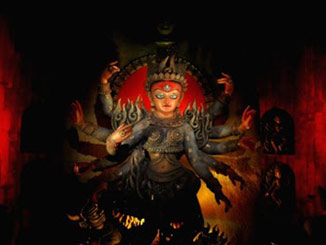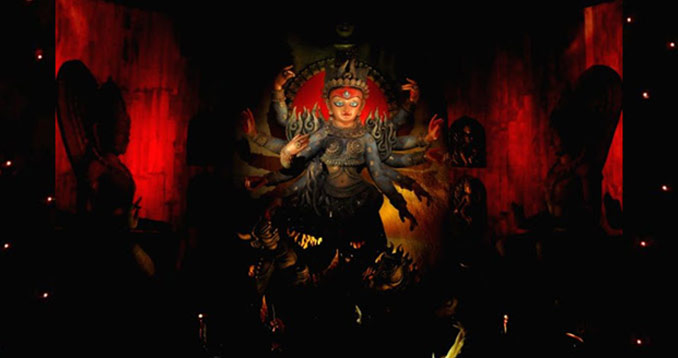

Navratri (Hindi: नवरात्री, Gujarati: નવરાત્રી) or Shardiya Navratri is celebrated with great zeal across Northern and Eastern India. Navratri is the symbolic celebration of nine nights of battle of the good against the evil with the result of victory of the good on the tenth day. During this period, Mother Durga is worshipped as the deity of power, energy and wisdom.
Navratri is usually celebrated twice in a year—once during spring (Chaitra Navratri) and once during autumn (Sharad Navratri). Both these times witness planetary changes as per the lunar calendar.
The Festival is celebrated for nine nights and devotees pray, take part in the Dandiya Raas and Garba and offer prasad to please Goddess Durga.
Durga Puja is celebrated from the sixth day of Navaratri. This will continue for 4 days and then end with Vijayadashmi.
There are different tales behind the inception of Navratri.
Mahishashur, the King of Demons had started a war against the Gods in heaven. To combat him, all Gods including the trinity of Shiva, Brahma and Vishnu pooled in their divine powers to give birth to the mother of power and ‘Shakti’. Thus Goddess Durga was created and she with her power and wisdom killed Mahishasur after nine nights of furious battle against him. The tenth day of victory is thus celebrated as Vijaya Dashami– the day of victory of good over the evil.
Know More:The Fine Art of Mastering Dandiya Raas and Garba Dance.
Lord Rama was about to enter a war against Ravana to save Sita from his imprisonment in Lanka. Before starting the battle, Rama worshipped Goddess Durga seeking her blessings. For the puja, he required 108 lotuses. To complete the count, when Rama was about to remove one of his eyes, Goddess Durga emerged and blessed him with her divine ‘shakti’. Rama won the battle on that day.
Uma, the daughter of Daksh—the king of the Himalayas is said to come home for ten days during Navratri. Uma married Lord Shiva and this festival celebrates her home coming on earth.
Image Source: Kuntal Chakrabarty/IANS
Navratri: Nine Avatars of Goddess Durga
For nine nights, people observe the festival with utmost devotion and prayers. Each day is dedicated to one avatar of Durga Maa. Based on this, devotees have to wear the right colours on each day. Do you know what colour to wear on each Navratri night? Take a look!
Day 1:Shailaputri /Pratipada
On Pratipada, Goddess Shailaputri is worshipped. Shaila means mountain and putri means daughter. Since Goddess Parvati is the daughter of the Mountain God, she is given importance on this day.
Day 2: Brahmacharini/ Dwitya
On Dwitya, Goddess Brahmacharini is a form of Durga Devi and she is one who reduces anger. Hence, the second day is dedicated for this Goddess.
Day 3: Chandraghanta/ Tritya
On Tritiya, devotees worship Chandraghanta. It is believed that she has a third eye and fights against evil demons. During puja, jasmine flowers are offered to make her pleased.
Must Reads: Why does Goddess Durga Devi stare at us so magically?
Day 4: Kushmanda/ Chaturthi
On Chaturthi, the day is dedicated for Goddess Kushmanda. Her name means cosmic eggand she is known to spread energy and warmth to everyone.
Day 5 Skandamata/ Panchami
On Panchami, Goddess Skandamata is one who rules over Budha (the Mercury planet). She is revered as it is believed that she is fierce and loving.
Day 6 Katyayini/ Shashti
On the sixh day called Shashti, Durga is said to have taken the form of Devi Katyayani so that she could kill the King of Demons. Women offer prayers to get a peaceful married and family life.
Must Reads:Be Bold, Fashionable and Enjoy this Navaratri in Style!
Day 7 Kalaratri/ Saptami
On Saptami, the day is specially dedicated to Goddess Kalaratri. She is said to be fierce and have also frightened the evil spirits all over the universe. She is the most destructive avatar of Kali Devi and rules over Lord Shani (Saturn Planet)
Day 8 Mahagauri/ Ashtami
On the eigth day, people worship Mahagauri. She wears only white clothes on this special day and rides a bull. On this day, Kanya Puja takes place- a special event dedicated for young virgin girls. This day is known as Mahashtami or even Maha Durgashtami. The day is celebrated with dance, fun and prayers.
Day 9 Siddhidaatri/ Navami
On Navami, Devi Siddhidaatri is given importance. She is powerful to fulfill all your wishes and hence the ninth day is dedicated to her.
Day 10 Vijayadashami (Dussehra)
After the 9 days of prayers, the tenth day is kept aside for Vijayadashmi. A day when new things can begin in life. It is also called Vidyarambham– an event where children are introduced into the world of education. Sindhoor Khela is a very important part of the rituals on Vijayadashmi.
Rituals of Navarathri
During the nine nights of worship, Goddess Durga is worshipped as ‘Shakti’—the deity of power for the first three days; the next three days she is worshipped as Lakshmi—the deity of wealth and the last three days, she is worshipped as Saraswati—the deity of knowledge and wisdom.
During this period, devotees keep fasts and usually avoid grains, onions, meat and alcohol in their meals. Special Navratri food is prepared in North India for such devotees keeping a fast.
Must Reads: Navaratri with Bollywood Celebrities
In Eastern India, Navratri is celebrated as Durga Puja and is the biggest festival throughout the year. Big pandals are set up, illuminated with light and different cultural activities are held during this time.
In Gujarat and Maharashtra, the Navratri dance is known as Garba and Dandiya where local people dance wearing traditional clothes and dandiya sticks in hand.
In Goa, special zatras start during Navratri and the Saraswat Brahmin temples are decorated for the festival. Devotees worship the Dasha Maitrikas with sandalwood paste, kumkum and new clothes & ornaments.
In Kerala, on the ninth day Ayudha Puja is done to bless all the tools in the house.

Leave a Reply